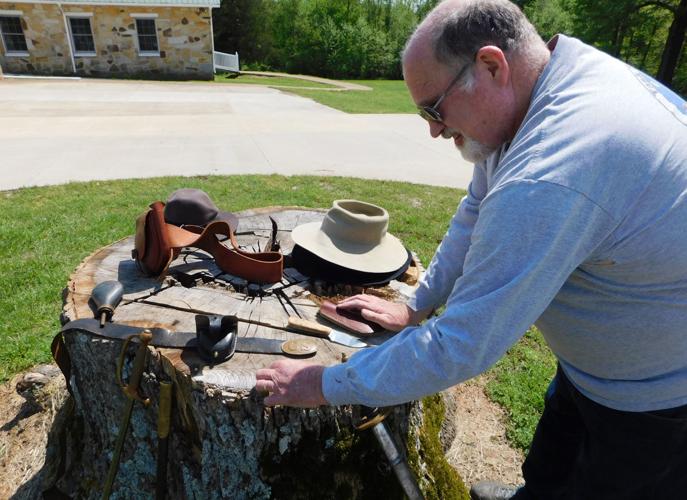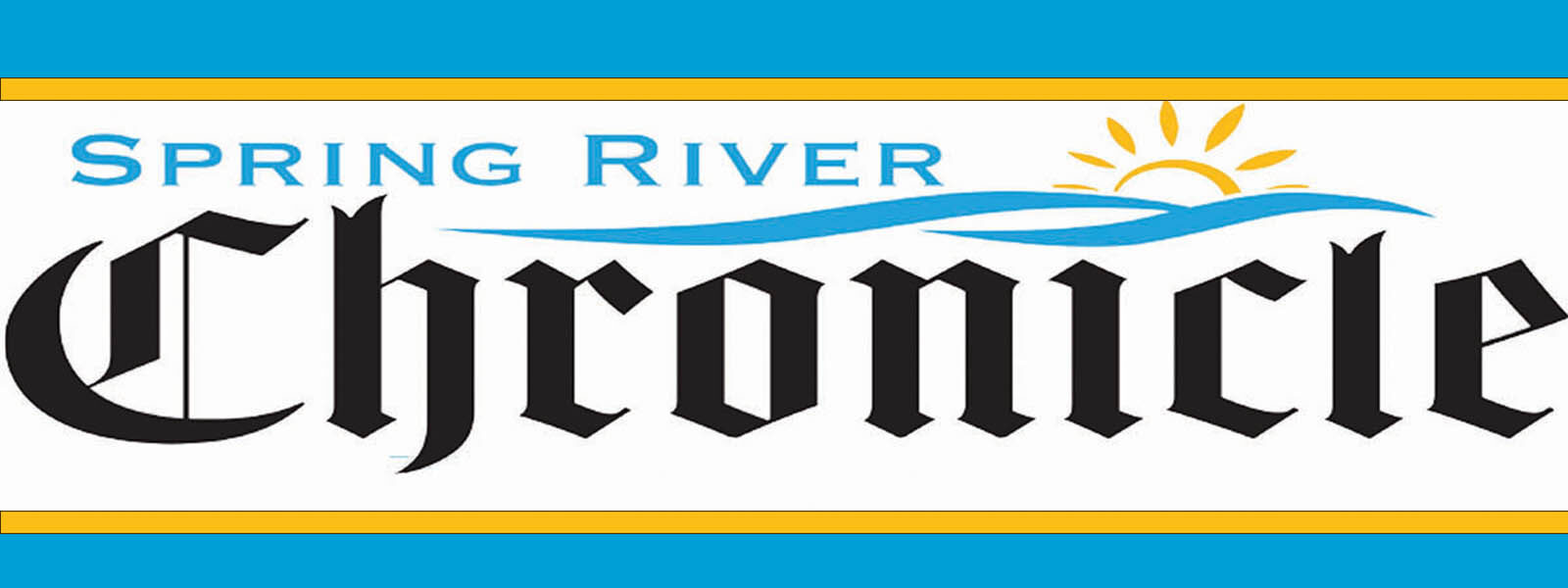By: BRENT TIPTON
Civil War Reenactor and historian
The slated Civil War reenactment of the Skirmish at Smithville or Fight on Osborne’s Creek set for June 17-19 at the Jackson Farm near Smithville has been temporarily canceled. The reenactment would have been held exactly 160 years to the date of the actual event.

Local historian Brent Tipton shows off some of his Civil War Memorabilia recently in front of the New Hope Church at Black Rock where a portion of the cancelled reenactment was set to take place.
Area historian, reenact and expert on the skirmish, Brent Tipton said, “Due to unseen circumstances Jackson Farm cannot host the reenactment as planned.” He said he hopes to be able to reschedule it during the fall.
Tipton said the story of the skirmish is very fascinating and despite having to cancel it, he feels the story is very interesting and part of local history, which involves an unsolved mystery and is worth telling.
“The impact of the Skirmish and historical significance has basically been overlooked by State and National Historian’s for years, and the story deserves its place in well known Civil War History. The Official report of the Union Commander, Major AH Seley, reads like a classic cavalry movie. I will briefly outline the skirmish and events, and information about the participants in the fight, ” he said of the skirmish.
Below is the story of the skirmish told by Tipton.
The Skirmish at McKinney Farm aka Skirmish at Smithville/Fight on Osborne’s Creek
June 17 1862 (Mid to Late Evening)
Place: James McKinney Farm, then Lawrence, Now Sharp County, approximately 4 miles North and west of Smithville, Arkansas
Weather: Torrential Rainstorm
Combatants: US (Union) Companies D, F, L Detachment/Outpost Commander, Major A.H. Seley
CS Company E of W.O. Coleman’s Missouri Cavalry Commander Captain Wiley C. Jones
Summary of the Skirmish:
During the Evening and night of 16 June 1862, AH Seley, moved 2 companies and his outpost headquarters from one mile southeast of Smithville Arkansas to the Milligan Cumberland Presbyterian Church and Campground. During the early morning of 17 June, Major Seley has a patrol sent out from Company D, under the Command of 1st Lieutenant Wilson. The patrol was supposed to gather cattle for the camp and to escort a loyal union family from Smithville into the camp at Milligan Campground, just South of Calamine. Lt. Wilson while on patrol is flagged down by a woman from a local farm, who informs Lt. Wilson that “100 men from Coleman’s” was planning to ambush the patrol. Lt. Wilson withdraws back toward the Camp. and he sends a dispatch to Major Seley. because of the weather, terrain and the fact his three companies were some distance from the McKinney Farm, it took considerable time to locate and send the companies, took considerable time for the companies to consolidate and organize and plan. They then had to locate Captain Jones. Captain Jones, in the mean time sought shelter from the storm on the James McKinney farm, who was a neighbor, friend, and Masonic Lodge brother. Captain Jones and 15 of his men sheltered in the farmhouse, barn, and other log structures. The rest of the Company dismounted to find shelter in the woods. The 5th Illinois finally locates Captain Jones and they march/ride to contact and attack the Confederates. It is still raining in torrents.
15 men of the 5th approach the farm, this draws the Confederate attention, but Captain Jones is caught off guard and cutoff from the rest of the Company. Company E opens up with a volley on the 5th Illinois Cavalry Scouts, and then the Union soldiers who were dismounted poured fire into the house and log buildings and then the main body charges, armed with sabers and Remington New army Revolvers ride within 12 feet of the buildings. One Company E soldier was killed. one of the 5th Illinois Cavalry is mortally wounded during the charge, and dies. The remaining men of Captain Jones company, realizing their peril, and being unable to organize a defense, all ride as a mob toward the ford over the Strawberry River in order to escape. It is blocked by soldiers from the 5th Illinois. The Confederates start shooting and force their way to escape. In the process Private Marvin Welker, of the 5th Illinois is killed.
It took the 5th Illinois Cavalry to locate and treat the wounded, and deal with the dead, and prepare to return to headquarters. The 5th Illinois Cavalry arrive at Milligan Campground during the early morning hours on the 18th of June, ending the skirmish. However due to the skirmish, the 5th Illinois Cavalry was delayed from moving to Jacksonport as ordered to support General Curtis in a Campaign against Little Rock, for many reasons, including the fifth being delayed, Curtis decided to Consolidate all the Union Forces at Helena. The rest of the 5th Illinois Cavalry left Pocahontas to catch transport to Helena at Jacksonport. Due to the possibility of the rest of Coleman’s Regiment and the skirmish, Seley and his men were delayed. They literally miss the boat to Helena and had to ride and slug their way through rivers, creeks, swamps in hostile territory.
Mysteries:
It is unknown if the two 5th Illinois Troopers are still buried at Milligan Campground Cemetery (No records show they were ever removed).
It is unknown who the lone Confederate was, and whether or not he was moved. It is thought he is in an unmarked grave but not certain.
What were Arkansas Soldiers from Lawrence and Sharp County doing in a Missouri Cavalry Regiment and why were they in Arkansas?
There is compelling evidence as to the answe, but no smoking gun as to written documents.
Who were the actual members of the Confederate Company, records and rosters have not been found.
Leads: it is thought that as Price was in the Process of being Commissioned in Confederate service, Price was allowing units of the Missouri State Guard to transfer to Confederate service. Three of Coleman’s Regiment that was recruited in Arkansas, were released by the Missouri State Guard, to return to Arkansas to muster into active confederate service. The skirmish occurred on the last day of Missouri State Guard orders. So the legitmacy and official status of the regiment has been called into question.
As to the lone Confederate KIA. a possible lead, is Private John Cardwell, who owned a small farm near Evening Shade. records indicate his Company was recruited in Lawrence/Sharp County in May 1862. In FEB 1863 his wife applied for aid for Indigent Confederate families.
It was standard practice by US Army to bury the dead near the hospital at the headquarters in temporary graves to await orders or for family to claim the body.
Records of the contractor that moved union soldiers after the war to the National Cemeteries.
No records have surfaced in Illinois that the two KIA of the 5th Illinois Cavalry were ever recovered or moved. It is thought that, most likely, they remained in the Campground Cemetery.
It was the biggest skirmish in the Sharp/Western Lawrence County area by size of forces involved as well as the number of casualties.
This news agency will continue to update the public when an alternate date for the reenactment is set.
